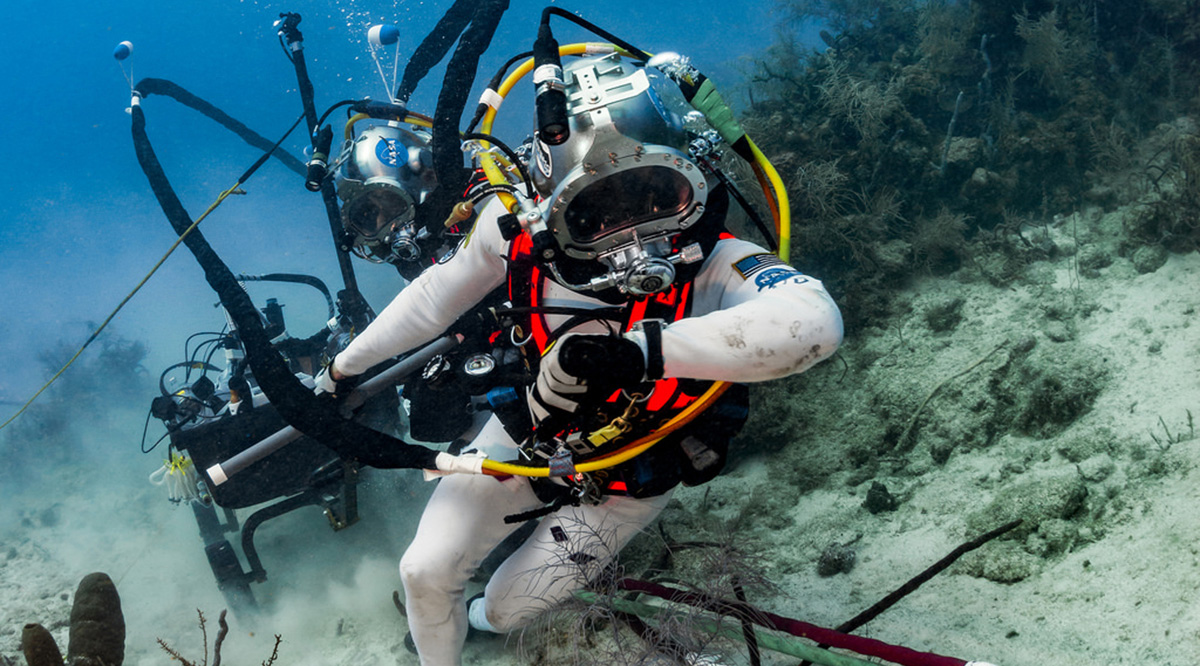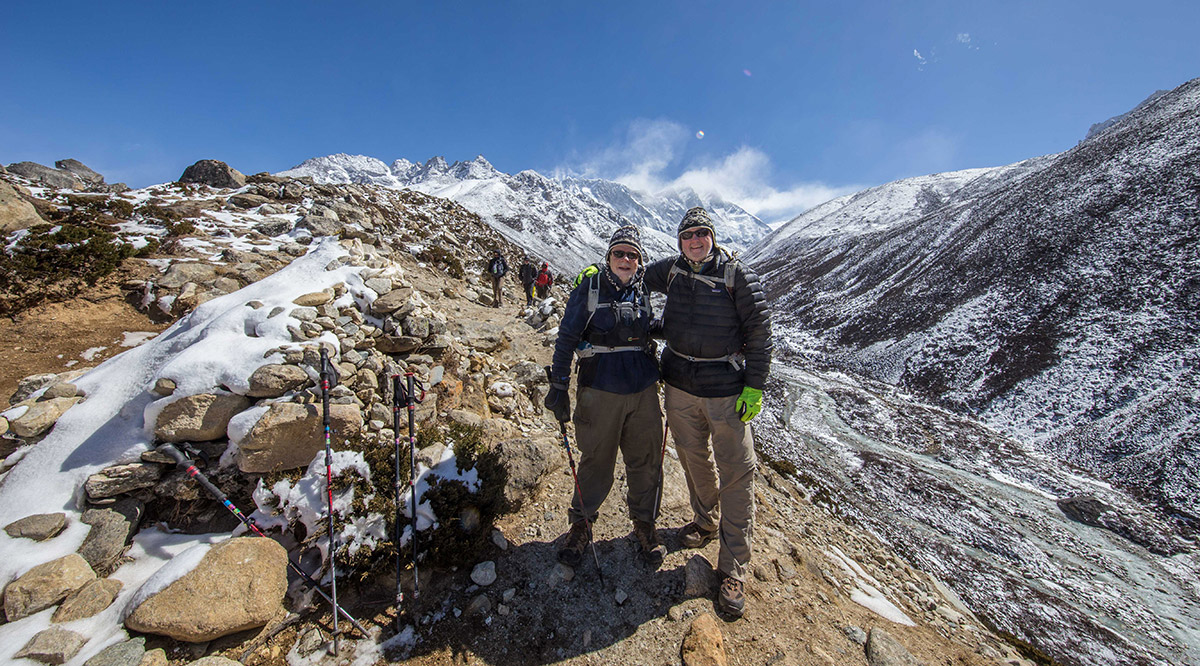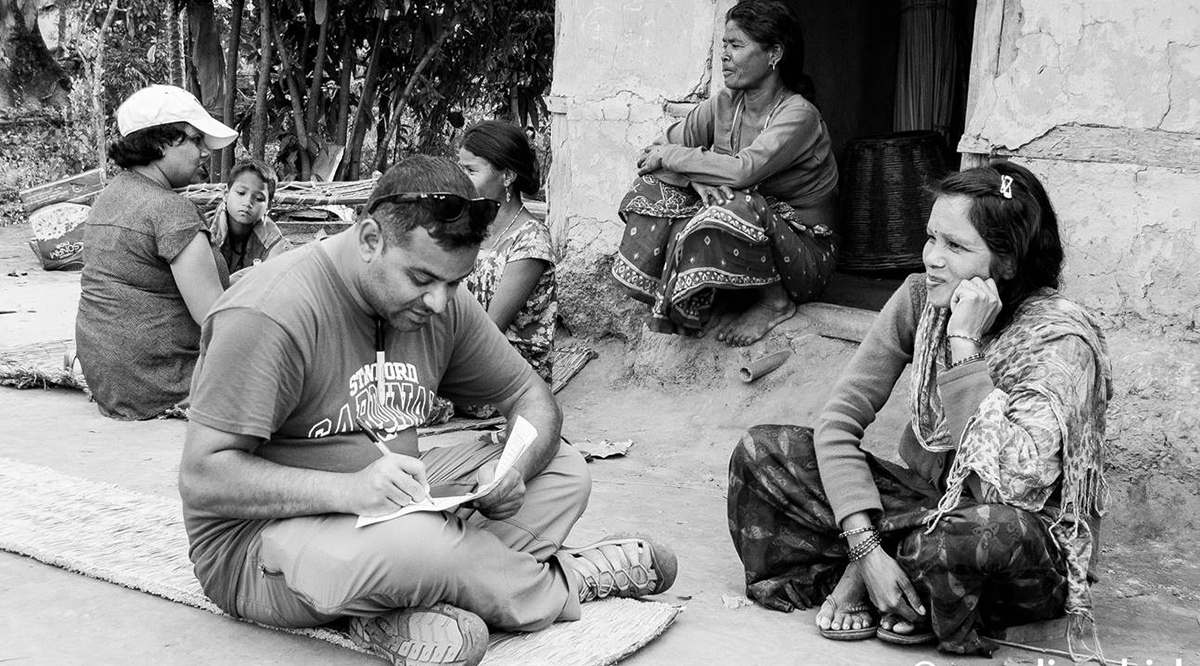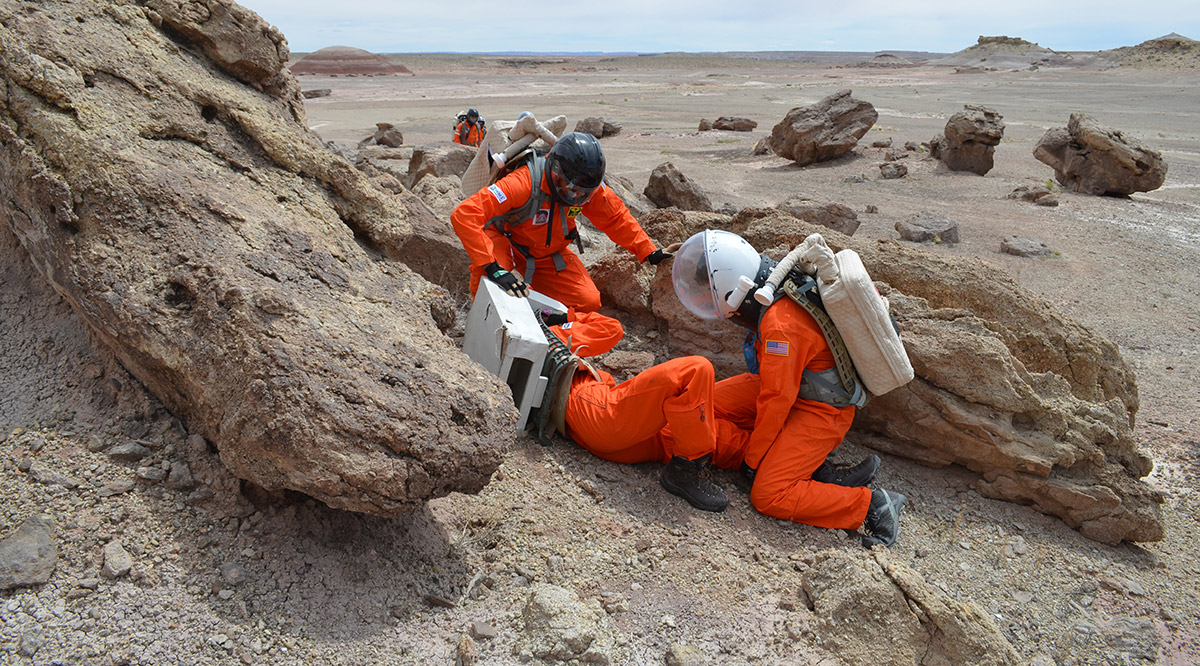
Think biomedical research and you may envision test tubes, microscopes, and rows of petri dishes. But for some scientists, conducting research instead means strapping on scuba gear, scaling the slopes of Mount Everest, joining foraging tribes on a South Asian hillside, or embarking on other equally remote adventures. Sometimes, the work involved is uncomfortable or downright dangerous. But these researchers say it also can be exhilarating to advance medical knowledge in ways that aren’t feasible without such severe conditions or far-flung treks.
Here are profiles of several scientists who went to extremes, not just for a change in scenery, but because — as Martin Cetron, MD, an Emory University School of Medicine professor and supervisor at the Centers for Disease Control and Prevention (CDC), says — “That’s where you had to go to do the work.”
On top of the world
It was a simple question. During a presentation, Richard Moon, MD, a professor of anesthesiology and medicine at Duke University School of Medicine, was asked, Why study people at high altitudes?
Moon, who also directs Duke’s Hyperbaric Center, recited a boilerplate explanation: At high altitudes, blood oxygen concentrations are often far below normal. This potentially dangerous condition, called hypoxia, also crops up in medical contexts from anesthesiology to critical care.
As Moon sat down, a colleague leaned over to critique his answer. “What you should have said is that [at high altitudes] people expose themselves voluntarily to degrees of hypoxia that no human experimentation committee would ever allow.”
That, Moon concedes, was right. “I’m sure if I went to the Duke Institutional Review Board and proposed lowering people’s oxygen saturation to below 60%, it would never be approved. But on our Everest trek we found that people were at that level all the time.”

In 2013 and again in 2017, Moon and several Duke colleagues took advantage of an opportunity to join Mount Everest hikes organized by British scientists, where they would study high-altitude trekkers under field conditions.
“One of the questions that is very important clinically is how low can you go” in blood oxygenation without causing serious damage, Moon explains.
During his recent trek, Moon asked fellow hikers to strap on a pulse oximeter — a watch-like device with a probe that connects to the wearer’s finger or forehead — so he could monitor their oxygen saturation. He instantly had more subjects than he could stuff into a hyperbaric chamber.
Several hikers were treated for acute mountain sickness and altitude-related cerebral edema, but others suffered no serious problems. At the highest camp, at an altitude of more than 18,000 feet, Moon recorded his own lowest reading: below 60% oxygen saturation. Others recorded even lower readings, Moon noted, “which, if seen in any of our hospital patients, would elicit panic.” Now, he believes, low levels in some circumstances may not be as dangerous as once thought.
Also on Moon's agenda has been recruiting volunteers — primarily mountaineering guides — for a project with British investigators on epigenetic changes in people whose bodies adapt to the lower oxygen levels of high altitudes.
“Imagine if we had a drug that could induce that adaptation,” says Moon. If patients needing oxygen treatments could manage with lower levels, they might avoid some of the treatment’s risks, which include nerve, eye, and lung damage. “For people who are in the ICU with lung failure, we wouldn’t have to give them as much oxygen,” he notes. "What a huge advance that would be.”
Under the sea
To better understand how human physiology — from brain function to the gut microbiome — responds in a pressurized environment, Dominic D’Agostino, PhD, dove 62 feet beneath the surface to an undersea laboratory called the Aquarius Reef Base, off Key Largo, Florida.
D’Agostino is an associate professor of molecular pharmacology and physiology at the University of South Florida Morsani College of Medicine. A trained diver, his research interests include how to prevent oxygen toxicity seizures, which can occur when a person breathes concentrated oxygen. The seizures threaten patients undergoing hyperbaric therapy for such medical issues as decompression sickness and wounds that won’t heal — and they can be fatal.
As D’Agostino dove deeper — literally and figuratively — into physiology in extreme environments, he met NASA workers who replicate the weightlessness of space by going under water. Those connections got him invited on a 2017 NEEMO (NASA Extreme Environment Mission Operations) mission to the Aquarius lab, which is run by Florida International University.
“I was about jumping out of my skin and pinching myself. I wanted to incorporate as much science as possible into that mission,” D’Agostino says.
After strapping on scuba gear, the crew members swam down to Aquarius and popped up in a chamber where trapped air prevented the sea from rushing in. The air is more than twice as dense as at sea level, explains D’Agostino. “You feel it when you’re breathing it, and you feel it when you talk.”
For ten days, the crew followed a packed schedule. “We would do about half the science inside the habitat and about half outside,” D’Agostino explains. Among his tasks was collecting data on pressure-related changes in sleep, skin microbiomes, metabolic markers, strength, and decision-making.
The work, which included studying their own bodies under demanding conditions, was worth the effort, D’Agostino notes. “I can say without reservation that the NASA NEEMO mission was the most intense, amazing experience of my life,” he says. “It’s the only habitat really in the world that can allow us to do this kind of science.”
Down dusty roads
One day, while studying the gut microbiome in rural tribes in Nepal, Aashish Jha, PhD, was apportioning human waste into glass vials. A villager expressed concern. She knew he had gone to college for many years. “If we send our children to college, will they have to do something like this also?” she asked.
But Jha, a post-doctoral researcher at the Stanford University School of Medicine, was delighted to spend many months collecting stool samples.
For the stint in 2016, Jha selected several tribes far from major roads and markets. All had been nomadic hunter-gatherers, but some had changed over time. The Tharu, for example, had developed agriculture about 300 years ago, and the Raji had begun farming more recently. The Chepang were the hardest to reach. Still foraging wild fruits and vegetables, they lived on a barren hill accessible only by four-wheel drive.
Because these tribes were exposed to similar bacteria in a close geographic area, and because their lifestyles diverged only recently, they provided “very nice comparison groups to understand how the human gut microbiome deviates from a traditional foraging type as humans move closer and closer to agriculture,” says Jha.

A stranger asking for human waste might be a difficult sell, but Jha worked with anthropologists and others who already had ties with the groups.
The concept of microscopic bugs in the digestive tract wasn’t very difficult to explain. “It wasn’t that foreign a concept for people, because people in Nepal get helminth infections all the time,” Jha says. Helminths are visible parasitic worms. “So when we tell them there are little tiny bugs in their gut, they think of helminths.”
Jha found that the villagers’ microbiomes lined up on “a very nice gradient of microbial shift,” with the foraging Chepang at one end and the agricultural Tharu at the other. Bacterial species common in foragers were scarce or nonexistent among farmers — and vice-versa. Many of the bacteria found among the tribes were absent from the American microbiome, which is representative of people who rely on industrial agriculture.
Jha hopes that additional studies will clarify the possible role of missing bacteria in conditions such as irritable bowel syndrome, rheumatoid arthritis, and celiac disease that appear to be mediated by the microbiome.
A big question is what role the missing bacteria play. “Whether they are medically relevant, we don’t know,” says Jha. “That is the next step that we are exploring.”
A week on “Mars”
As a professor of emergency medicine at the University of Colorado School of Medicine, Ben Easter, MD, is, quite naturally, concerned about emergencies.
But the emergencies that most interest Easter will occur on Mars.
To help anticipate problems that humans could encounter on the red planet, Easter works at the Mars Desert Research Station, located in a barren stretch of Utah he describes as “absolutely Martian.” There he dons a spacesuit, communicates via a radio in his helmet, and leads students, physicians, and engineers in simulated life-and-death struggles on week-long missions. Since 2015, Easter has led a half-dozen courses at the station, which is run by the nonprofit Mars Society.
“I’ve always been interested in space, long before I ever wanted to be a doctor,” he says.

The Mars “crew” lives in a habitat equipped with solar panels, a research dome for lab work, and electric vehicles for traveling outside. They periodically pull on spacesuits, sit patiently in a simulated airlock, and exit the station for “extravehicular activities,” such as collecting soil samples.
But sometimes someone — often Easter — suddenly comes sliding down a rocky outcrop feigning a broken limb and bearing a tear in his spacesuit that’s gushing oxygen.
“So the group has to find and isolate the leak and patch the leak to prevent the person from getting decompression sickness. In addition to taking care of the suit, they have to figure out how they’re going to evacuate their injured crew member back to the habitat,” says Easter. “The amazing thing is how much we were able to create scenarios where the crew really buy into their environment.”
The Mars simulations provide a helpful supplement to Easter’s other work as a researcher at Johnson Space Center, where he uses mathematical models to anticipate extraterrestrial emergencies. But Easter most values the missions’ chance to educate and inspire.
“We’ve had some of our students and physicians significantly alter their careers to pursue work in space medicine or a space industry-related field,” he says. “Being able to put together a week-long course that people are really excited about and then give them that spark to change what they’re doing with their life and pursue something that they really enjoy, I think that’s what I’m most proud of.”
From leprosy in India … to the CDC
Among his research efforts, Martin Cetron, MD, developed field tests in southern India for the early diagnosis of leprosy and collaborated with local teams in northeastern Brazil to uncover the source of a protozoan that was causing the sometimes fatal disease leishmaniasis.
Along the way, he contracted intestinal diseases, malaria, and schistosomiasis, which he calls “a poignant reminder of the connection between field research and the patient experience.”
But a bit of medical detective work for the CDC in Africa’s Lake Malawi in 1992 changed the course of his career.
“I thought I was coming here for a two-year stint to learn more about parasitic infections from the world’s experts and would go back to an academic research and clinical career,” he says.
Instead, he found himself solving mysterious instances of schistosomiasis, which is caused by a snail-based parasitic flatworm. The cases involved a complex, tangled story: After drought ravaged corn crops, desperate villagers turned malaria bed nets into fishing gear, and they then overfished a predator that usually reduces the snail population. Cetron ultimately discovered that 90% of village schoolchildren had been infected without anyone realizing.
He marvels at the irony that “the intended public health intervention of bed nets to prevent hyperendemic malaria” enabled the schistosomiasis epidemic. “I was so dumbfounded that I spent the rest of my working life at CDC exploring the intersection of pathogens, hosts, human behavior, and the environment.”
Cetron is now director of the CDC Division of Global Migration and Quarantine and an adjunct associate professor at the Emory University School of Medicine. His work involves overseeing several international efforts, including a project that detects disease outbreaks by collecting data from a network of clinics that serve international travelers. “Human migration is complex and challenging in the context of disease emergence and spread,” says Cetron. When it comes to germs, he notes, “travelers are essentially sampling the world.”
Networks allow much surveillance to be done from afar, but if a disease is particularly worrisome or complex, Cetron will dispatch a field team.
Among the newsworthy epidemics he and his staff have investigated are the H1N1 influenza pandemic of 2009, Ebola outbreaks from 2014 to the present, and the 2015 Zika virus outbreak.
“You need to have a global surveillance network that provides eyes and ears and is constantly taking the pulse of what’s happening out there in a world that is highly mobile and interconnected,” he says. Those networks are “much bigger, more robust, and more enduring than what any one individual can do alone.”